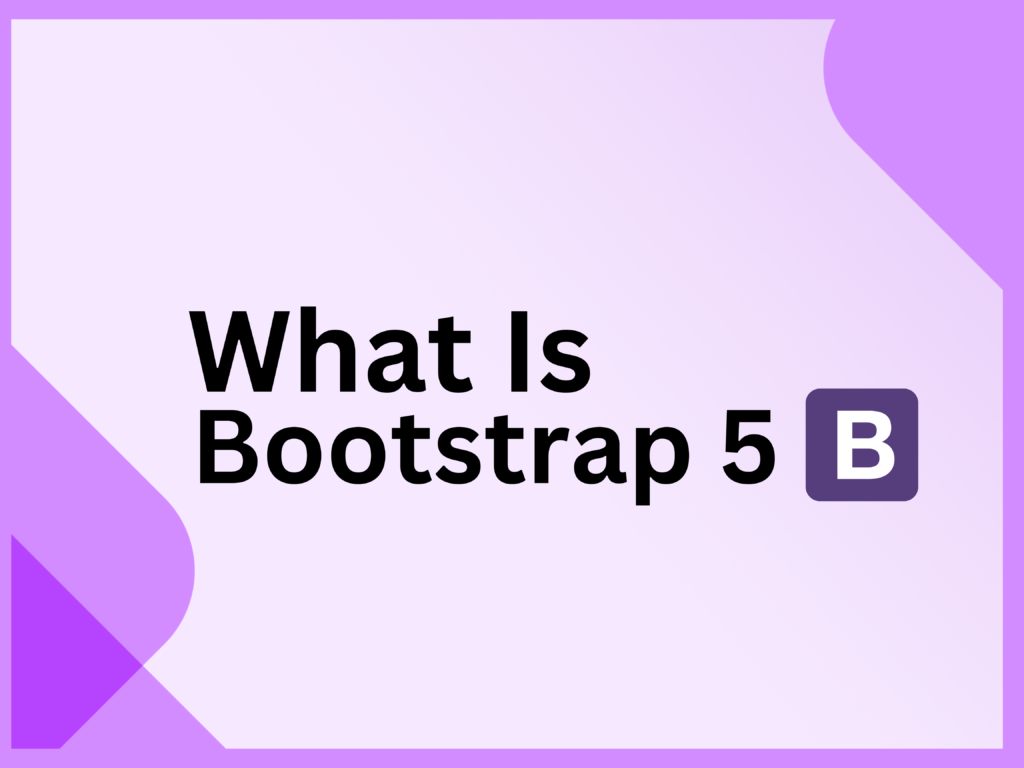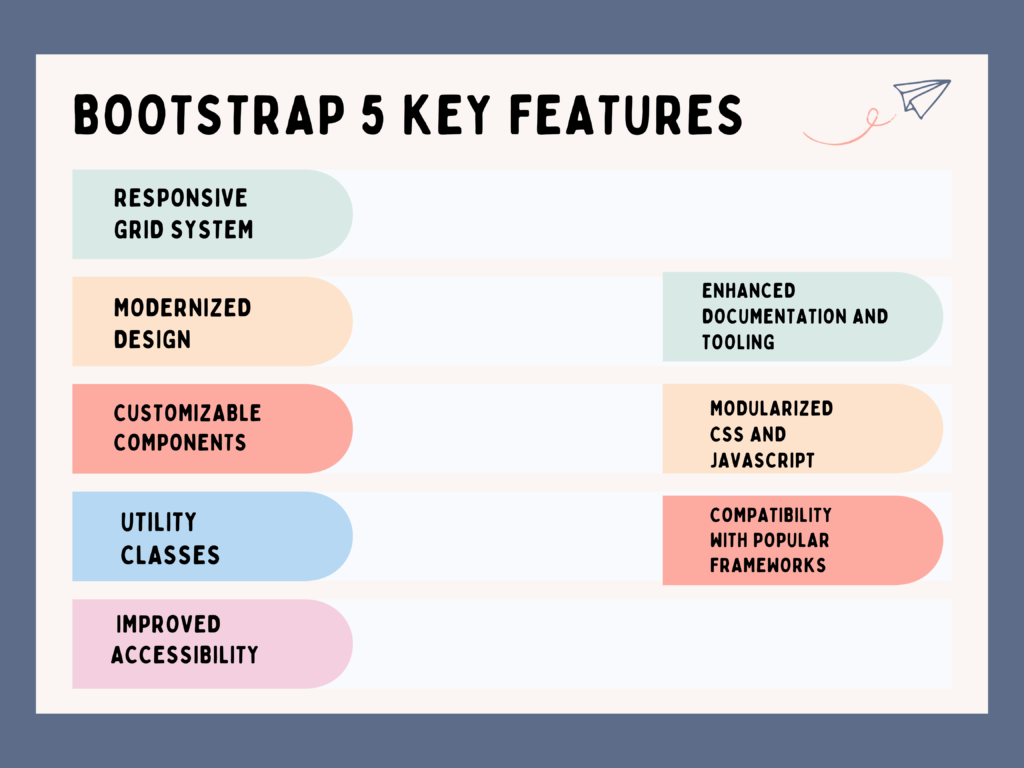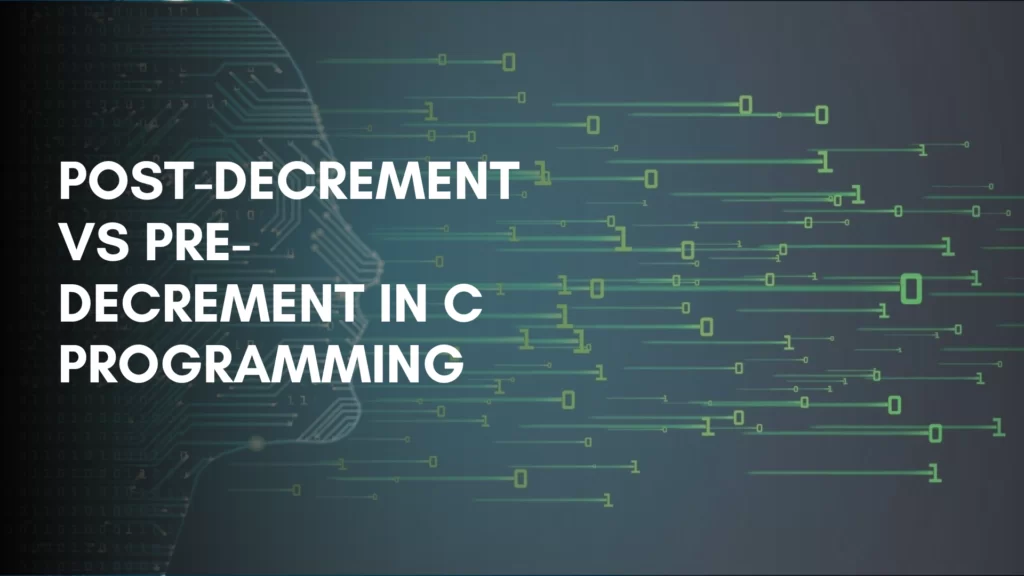Welcome to our Bootstrap 5 tutorial! In this tutorial, we’ll dive into the world of Bootstrap 5, a powerful front-end framework that allows you to build responsive and mobile-first websites with ease. Whether you’re a beginner looking to learn the basics of Bootstrap or an experienced developer seeking to take your skills to the next level, this tutorial has something for you.
Throughout this tutorial, we’ll cover everything you need to know to get started with Bootstrap 5. We’ll explore its key features, components, and utilities, and we’ll walk you through the process of building a responsive website from scratch. By the end of this tutorial, you’ll have the knowledge and skills to create stunning websites that look great on any device.
So, if you’re ready to unlock the full potential of Bootstrap 5 and take your web development skills to new heights, let’s dive in!
Table of Contents
ToggleWhat Is Bootstrap 5?
Bootstrap 5 is a popular open-source front-end framework that simplifies the process of building responsive and mobile-first websites and web applications. Developed by the team at Twitter, Bootstrap has gained widespread adoption among developers for its ease of use, robust components, and flexibility.

At its core, Bootstrap 5 provides a comprehensive set of HTML, CSS, and JavaScript components and utilities that can be easily integrated into web projects. These components include buttons, forms, navigation bars, cards, modals, and more, allowing developers to create visually appealing and functional user interfaces with minimal effort.
Overall, Bootstrap 5 is a powerful tool for web developers looking to streamline their workflow and create modern, responsive websites and web applications. Its ease of use, extensive documentation, and large community make it an ideal choice for projects of all sizes.
Among Bootstrap 5 Key Features Are:

1. Responsive Grid System: Bootstrap 5 includes a powerful and flexible grid system that allows developers to create responsive layouts for their websites and web applications. The grid system is based on a 12-column layout and supports multiple breakpoints for designing layouts that adapt to different screen sizes.
2. Modernized Design: Bootstrap 5 introduces a refreshed and modernized design compared to previous versions. It includes updated styles, components, and utilities to align with modern web design trends and provide a more polished look and feel.
3. Customizable Components: Bootstrap 5 offers a wide range of customizable components, including buttons, forms, navigation bars, cards, and more. Developers can easily customize the appearance and behavior of these components using CSS classes or Sass variables to match their project’s design requirements.
4. Utility Classes: Bootstrap 5 provides a comprehensive set of utility classes for common styling tasks, such as spacing, typography, alignment, and colors. These utility classes allow developers to apply styles quickly and efficiently without writing custom CSS, making it easier to create consistent and visually appealing designs.
5. Improved Accessibility: Accessibility is a key focus in Bootstrap 5, with enhancements to ensure that websites and web applications built with Bootstrap are accessible to users with disabilities. This includes improvements to keyboard navigation, focus management, and semantic HTML markup.
6. Enhanced Documentation and Tooling: Bootstrap 5 comes with improved documentation and tooling to help developers get started quickly and efficiently. The documentation includes detailed explanations of components, utilities, and best practices, along with examples and code snippets to aid in implementation.
7. Modularized CSS and JavaScript: Bootstrap 5 adopts a modularized approach to CSS and JavaScript, allowing developers to include only the components and styles they need for their projects. This helps reduce file size and improve performance by eliminating unused code.
8. Compatibility with Popular Frameworks: Bootstrap 5 is designed to work seamlessly with popular front-end frameworks and libraries, such as React, Vue.js, and Angular. This makes it easy to integrate Bootstrap into existing projects or use it alongside other frameworks as needed.
Why Do We Use Bootstrap 5?
Reasons to Use Bootstrap 5:
1. Rapid Development: Bootstrap 5 allows developers to build responsive and mobile-first websites and web applications quickly and efficiently. Its extensive library of components, styles, and utilities streamlines the development process, enabling developers to create polished designs with minimal effort.
2. Cross-Browser Compatibility: Bootstrap 5 is designed to work seamlessly across different browsers and devices, ensuring a consistent user experience regardless of the platform. Its responsive grid system and components adapt fluidly to various screen sizes, making it easy to create designs that look great on desktops, tablets, and smartphones.
3. Consistency and Uniformity: Bootstrap 5 provides a set of predefined styles and components that follow consistent design patterns and best practices. This helps maintain uniformity across different sections of a website or web application, resulting in a cohesive and professional-looking design.
4. Flexibility and Customization: While Bootstrap 5 offers a wide range of ready-to-use components and styles, it also provides flexibility for customization. Developers can easily modify and extend Bootstrap’s default styles and components using CSS overrides, Sass variables, or custom JavaScript, allowing them to tailor the framework to their specific design requirements.
5. Accessibility: Accessibility is a priority in Bootstrap 5, with built-in features and enhancements to ensure that websites and web applications built with Bootstrap are accessible to users with disabilities. This includes semantic HTML markup, keyboard navigation support, and focus management improvements, making Bootstrap 5 a suitable choice for creating inclusive and accessible designs.
6. Community and Support: Bootstrap has a large and active community of developers, designers, and contributors who regularly contribute to the framework’s development and provide support to users. The extensive documentation, tutorials, forums, and resources available for Bootstrap make it easy for developers to learn, troubleshoot, and collaborate on projects.
7. Integration with Other Technologies: Bootstrap 5 integrates seamlessly with other front-end technologies and libraries, such as jQuery, React, Vue.js, and Angular. This makes it easy to incorporate Bootstrap into existing projects or use it alongside other frameworks and tools as needed, providing flexibility and interoperability.
Overall, developers use Bootstrap 5 for its speed of development, cross-browser compatibility, consistency, flexibility, accessibility, community support, and integration capabilities, making it a versatile and popular choice for web development projects of all sizes and complexity levels.
Note: The main difference between Bootstrap 4 and Bootstrap 5 is that jQuery is no longer needed.
Getting Started With Bootstrap 5 Tutorial
As previously said, Bootstrap 5 makes it simple to develop stunning responsive webpages. For a “Getting Started with Bootstrap 5” tutorial, you’ll want to provide a step-by-step guide for beginners on how to set up Bootstrap 5 in their projects and start using its features. But how it is very important to get an overview of Bootstrap 5. We have included a comprehensive description of the Bootstrap 5 introduction in this section.
- Introduction
Advice: This comprehensive Bootstrap 5 lesson covers every significant chapter with numerous real-world examples that can quickly improve your comprehension of any given subject or topic.
Bootstrap 5 Layout
Bootstrap 5 provides a robust and flexible layout system that simplifies the process of creating responsive designs for websites and web applications. At its core is the grid system, a powerful tool that allows developers to organize content into rows and columns, creating a structured and visually appealing layout. With Bootstrap’s grid system, developers can easily create layouts that adapt seamlessly to different screen sizes and devices, ensuring a consistent user experience across desktops, tablets, and smartphones.
- Breakpoints
- Containers
- Grid System
- Column
- Gutter
- Utilities
- Z-index
Overall, Bootstrap 5’s layout system provides developers with the tools and flexibility they need to create visually stunning and responsive layouts for their web projects. Whether you’re building a simple website or a complex web application, Bootstrap’s layout system offers the versatility and scalability to meet your design needs and deliver an exceptional user experience.
Bootstrap 5 Content
Bootstrap 5 Content provides a comprehensive set of components and utilities for managing and displaying content within web pages and applications. With its rich collection of components, developers can easily create engaging and visually appealing content layouts that enhance the user experience.
- Reboot
- Typography
- Images
- Tables
- Figures
Bootstrap 5 Form
The core components of Bootstrap 5 Forms include form controls such as text inputs, checkboxes, radio buttons, select dropdowns, and file inputs. These components come with predefined styles and behaviors that ensure consistency and compatibility across different browsers and devices. Developers can easily customize these form controls using Bootstrap’s utility classes and CSS variables to match the design requirements of their application. To obtain a general understanding of how to utilize these components, explore this section.
- Form Control
- Select
- Checks and Radios
- Ranges
- Input Group
- Floating Labels
- Validations
Bootstrap 5 Forms Layout
Bootstrap 5 Forms Layout provides a powerful toolkit for designing and structuring forms in web applications. With its flexible grid system and comprehensive set of form components and utilities, Bootstrap allows developers to create forms that are both visually appealing and highly functional.
- Forms
- Utilities
- Form Grid
- Gutters
- Horizontal form
- Horizontal form label sizing
- Column sizing
- Auto-sizing
- Inline forms
- Form Validation
Bootstrap 5 Components
A wide variety of pre-designed components is included with Bootstrap 5 to help you get started quickly with web development. These components have many different functions, ranging from simple buttons and form styles to intricate navigation menus, picture carousels, and modals.
- Accordion
- Alerts
- Badge
- Breadcrumb
- Buttons
- Button group
- Card
- Carousel
- Close button
- Collapse
- Dropdowns
- List group
- Modal
- Off-canvas
- Progress
- Scroll spy
- Spinners
- Toasts
- Tooltips
Bootstrap 5 Helpers
Take away the unnecessary CSS! Bootstrap 5 includes useful helper classes that allow you to customize the appearance and experience of your website. These function as small switches for text alignment, borders, and spacing, among other things.
- Clearfix
- Colored links
- Position
- Ratio
- Stretched link
- Text truncation
- Visually hidden
Bootstrap 5 Utilities
With its utility classes, Bootstrap 5 simplifies style. These allow you to modify the look of your website and are similar to little toolboxes. Read this section to find out how to use these classes.
- Background
- Borders
- Colors
- Display
- Flex
- Float
- Interactions
- Overflow
The Advantages Of Bootstrap 5
- Beginning to code is made easier with Bootstrap.
- Bootstrap makes it simple to design interactive elements such as tabs, drop-down menus, and sliders.
- Cross-browser compatibility is one of the main advantages of using Bootstrap.
- Reduces the time spent coding the same items.
- Building a website that is geared for mobile traffic is made easier with Bootstrap 5.
- The Bootstrap community boasts a vast array of resources.
What’s New In Bootstrap 5?
jQuery Assistance: Bootstrap 5 is more user-friendly because it no longer requires the jQuery library. Without it, you may still utilize Bootstrap.
Custom properties in CSS: About twenty CSS custom properties are included in the generated CSS for Bootstrap 5, and many more are planned for further component customization.
Improved Grid System: Data is arranged and aligned using a set of containers, rows, and columns in Bootstrap 5’s grid system. It was created using Flexbox and is completely responsive.
Better Documentation: The documentation now has more details, especially on customization. Bootstrap 5 boasts enhanced customization capabilities along with a modern design.
Better form controls: Every custom form control in Bootstrap 5 can now be tweaked. Every control, including files, ranges, radio buttons, and checkboxes, looks and behaves the same in all browsers.
Bootstrap 5 Introduces API for Utilities: In Bootstrap 5, an API approach is used together with a new Sass language and syntax. This lets you modify or remove the defaults and also allows you to create new utilities.
New Bootstrap Icon Library: Bootstrap now offers an open-source, nearly 1,300 icon collection. It is designed primarily for the components of the framework, although it may be applied to any kind of project.
Bootstrap 5 FAQ’s
What is Bootstrap 5?
Bootstrap 5 is the latest version of the popular front-end framework Bootstrap, which is widely used for building responsive and mobile-first websites and web applications.
What is the current version of Bootstrap 5?
As of my last update, the current stable version of Bootstrap 5 is version 5.3.0, which was released on January 11, 2022.
What are the various techniques to use the Bootstrap 5?
You may use Bootstrap 5 in three different ways by downloading it from the official site and adding it locally; by setting up the necessary CDN links; or by using Yarn or npm instructions.
Is Bootstrap 5 supports the Mobile-First Design ?
Yes, Bootstrap 5 ensures the mobile-first approach by using a responsive grid system to adjust the various designs on the many sorts of device widths.
How to customize the Bootstrap 5 pre-defined Classes ?
Bootstrap 5 offers built-in Sass support for customizing variables, properties, and other elements. The resulting CSS is then obtained through recompilation.








